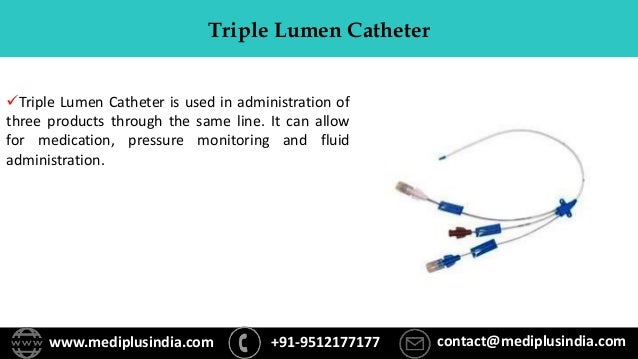
#Triple lumen central line skin#

vasoactive agents, chemotherapy or TPN administration) (4) Infusions of irritant substances (e.g. (1) IV access (especially if difficult peripheral access)

CVC is a cannula placed in a central vein (e.g.If you have any problems with your central line, talk to your healthcare provider. Injury to the vein or to lymph ducts near the veinĪir bubble in the blood (air embolism). An air embolism can travel through the blood vessels and block the flow of blood to the heart, lungs, brain, or other organs.īlood clot (thrombus) that can block the flow of blood. A blood clot can also travel through the blood vessels and block the flow of blood to the heart, lungs (pulmonary embolism), brain, or other organs.Ĭollapsed lung (pneumothorax) or buildup of blood between the lungs and the chest wall (hemothorax)Īccidental insertion into an artery instead of a vein This allows the provider to confirm the catheter’s position and check for problems.Īs with any procedure, having a central line placed has certain risks. The solution may include heparin, which prevents blood clots.Īn X-ray or other imaging test is done. The healthcare provider flushes the catheter with saline solution to clear it. It may be loosely attached to the skin with stitches to hold it in place. The other end of the catheter extends a few inches out from your skin. It’s moved forward until the tip of the catheter is in the vena cava, close to the heart. This numbs the skin so you don’t feel pain during the procedure.Īfter the pain medicine takes effect, the catheter is gently passed into the vein. Medicine (local anesthetic) is injected near the vein. These steps lower the risk for infection. The skin is cleaned with antiseptic solution. Only the spot where the line will be placed is exposed. You’re fully covered with a large sterile sheet. Your healthcare team can tell you what to expect. This may be done in your hospital room or an operating room. The central line is placed in your body during a brief procedure. This line is placed in a large vein in the groin. This line is placed into a large vein in the neck.įemoral line. This line is placed into the vein that runs behind the collarbone.

This line is placed in a large vein in the upper arm, or near the bend of the elbow. Peripherally inserted central catheter (PICC). The catheter is threaded through the vein until the tip sits in the large vein near the heart (vena cava). Which vein is used depends on your needs and overall health. The central line will be placed into 1 of the veins as described below. Ask your healthcare provider why you need the central line and which type you’ll get. It can also be used to measure blood flow (hemodynamic monitoring), to draw blood, or for other reasons. The line can deliver medicine or nutrition right into your bloodstream. What a central line doesĪ central line is often used instead of a standard IV (intravenous) line when you need treatment for longer than a week or so. It also explains how the central line is placed in your body.

This sheet describes types of central lines. When you no longer need the central line, it will be taken out. A small, soft tube called a catheter is put in a vein that leads to your heart. It’s also called a central venous access device (CVAD) or central venous catheter (CVC). You need a central line as part of your treatment. Central Line (Central Venous Access Device)


 0 kommentar(er)
0 kommentar(er)
